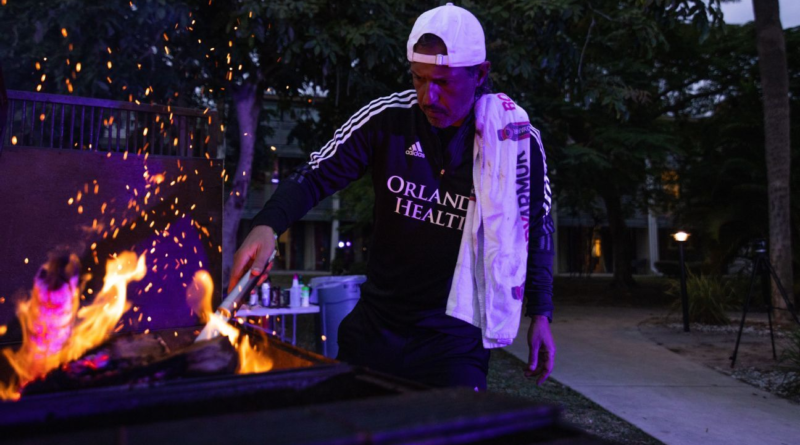In MLS, asado culture is the thing that bonds and brings teams closer together
There is magic in the smoked meat. At least, that’s what Josema Bazan believes.
Get a team of soccer players together at any point during the week and you can bet they’ll talk shop, reflecting on training, upcoming matches or past results. Unless, of course, you also put several cuts of beef on the parrilla, the Argentine-style grill, toss on some vegetables — and maybe some cheese? — and make them wait.
There’s no rushing the asado: the only thing more important than the taste of the meat are the conversations — no soccer, please — while it’s cooking.
Ranging from a fancy dinner out — like Don Julio in Buenos Aires, where Lionel Messi was mobbed on Monday — to you and a buddy using an old shopping cart in the backyard, the asado is both culinary heritage and social glue in Argentina and other South American countries.
It is both the act of cooking meat and the activity that surrounds getting together to eat it. Now, it’s going beyond those borders and taking over Major League Soccer.
“There are very few asados at which we talk about Saturday’s game. You talk about other things. You talk about experiences,” said Bazan, an Orlando City SC assistant coach and Major League Soccer’s most ardent asado aficionado. “There, we see we’re all flesh and blood and all normal people, that if we are all together, we can go very far. That’s the moment that happens at the asado.”
– Stream on ESPN+: LaLiga, Bundesliga, more (U.S.)
In 2019, then-San Jose Earthquakes manager Matias Almeyda used the asado — and cooked everything himself — as a means of rallying his struggling team. As the 2023 MLS season hits its stride, teams like Orlando City SC and FC Dallas made room for asados into their weekly or monthly training schedules, while other clubs host asados on special occasions. Elsewhere, an Argentine player might have a parrilla set up in his own backyard and invite teammates to join on a day off.
With a drink or two in hand, music playing and meat sizzling, hosting an asado has become an important way for the many Argentines playing in the league to share their culture and for teams to come closer together. No matter the frequency or the setting, the asado serves to build connections that go far beyond what fans see at the stadium each weekend.
“You talk a lot, enjoy time with friends,” said Luciano Acosta, a Buenos Aires native and midfielder preparing for his third season with FC Cincinnati. “We all tell lots of stories, sometimes we play cards. We talk about everything that sometimes at a regular party or gathering you wouldn’t be able to speak about or enjoy as much.
“In this moment, created by doing the asado, you enjoy those things more.”
Like any true believer, Bazan has devoted a not-insignificant part of his life to refining his faith and evangelizing to others, offering a taste of beef right off the parrilla to curious people passing his setup before an event, rather than going door-to-door in hopes you’ll embrace this custom.
So how does it work? First get the ingredients, then get the fire going to create smoke. While you put the food on and wait for it to cook, you have those different, deeper chats before enjoying the fruits of that labor.
“I think in sports it helps you because it is a ritual where everything is put together. It’s a normal group dinner, but it’s outside. That’s a bit out of the norm,” Bazan said. “The guys come, and something beautiful happens.”
In a country like Argentina, a country that famously loves red meat, the fusion between top-level soccer and top-grade beef didn’t catch flame until the 1990s, Bazan recalls. Before going to the hotel together on Friday night to concentrate on the weekend match, teams in Buenos Aires — and, from there, the rest of the country — started to prepare an asado. As technology and nutrition specialists became more integrated with clubs, the asados moved earlier and earlier in the week and away from matchdays, thereby guarding against the threat of “meat sweats” affecting performance.
And make no mistake: an asado can mean serious amounts of meat.
Glad to have @BBQsnob with us for the team BBQ this afternoon! Hope you enjoyed it! pic.twitter.com/5dt0e0ZMSG
— FC Dallas (@FCDallas) April 25, 2018
Bazan goes to three different butchers in Orlando, preferring vacio, or flank steak, from one shop, fajita meat from another and picaña — one of several Argentine cuts rarely used in American-style BBQ — from another.
Then it’s time to season. Bazan uses cooking salt, white pepper and a dash of paprika and garlic powder, making sure to spread everything evenly so each bite has flavor. Some use only salt, though others swear by a different mix of spices.
In terms of the cooking equipment, it’s not unusual for Argentine players in MLS to bring their barbecue style with them to the U.S., though Bazan might have taken it to new heights with 11 different devices for smoking meat at his disposal during his time in Dallas. Bazan works with local welders to make his grills to his specifications.
“I tell him wide here, narrow here, long here,” he says. He currently mans a custom-designed model with letters spelling “Orlando City” in black with purple trim bolted on to the steel frame.
Others aren’t as particular. Former Montreal star Nacho Piatti connected with a fellow Argentine expat in the city to have a parrilla installed on his patio, and bought meat from another Montrealer who imported it from Argentina.
“In Argentina, the majority of houses have a parrilla, but maybe when we go abroad it’s not that easy to get a proper parrilla,” San Jose Earthquakes winger Cristian Espinoza said. “It depends on where you live because some places don’t let you have one, but luckily both places where I’ve lived abroad, I was lucky enough to have a parrilla. Right now, in San Jose we really get together for a lot of asados.”
Apartment complexes — a common housing choice for players who aren’t home because of the rigors of the season — may not allow the parrilla because of the necessity to have an open flame. A parrilla is essentially a grate that holds meat and allows for wood and coals to go under it, onto which fat and excess steadily drip as the meat cooks. Some are extremely basic — two strips of metal, one above the other, holding the food and the fire source — but many are elaborate setups with multiple doors or various areas for preparing, cooking and serving.
Austin FC forward Maxi Urruti has played in six MLS cities and says it’s become easier and easier to get a good parrilla since his arrival in the league in 2013. “There are now sites that send them from Miami in two to three days. You just have to put it together,” he said.
Once a grill is acquired, it’s not too difficult to follow the other steps for a successful asado, but even before a trip to the butcher, materials will make or break the event.
“For me, the key of the asado is the firewood. If there’s charcoal, you can do a mix. It has to be burning well. It all starts there,” Bazan said.
“If it’s the offseason, find a good wine, a nice beer, start with mate,” says Acosta, describing the herbal tea enjoyed communally in Argentina and Uruguay. “Get a few cheeses on there and get the fire going on the patio. We’re warming up the parrilla, and once it’s ready you put the meat in so it cooks over the slow flame.”
“Without good players, you can’t play well. Without good beef, you can’t have a good asado,” Bazan said.
After the right meat, the right seasonings and the right cooking surface, another key component is time. “The person cooking doesn’t hurry. He knows that it takes time,” Urruti said. “If you want to eat fast, it’s better to order food because asado will take you time.”
That, say the Argentines currently based in MLS, is what creates the space needed to allow men competing with each other for starting minutes or even for each other’s jobs to let their guard down and start to talk about tougher topics: Finding friends and community, the pressures of parenting, the loss of a loved one.
In the forced pause created by the asado — generally 45 minutes of cook time, plus another 20 to 30 minutes for prepping and serving — an openness grows.
While putting cuts of beef on the parrilla and sipping mate might unquestionably be considered an Argentine act, Major League Soccer’s apostles of asado are finding plenty of buy-in from teammates of other backgrounds. With players from more than 80 nations playing in the league, most team’s rosters are made up of players from several different countries. Bridging those gaps that exist in language, in culture, in rituals and even in style of play can be difficult.
“The fact that we can sit and enjoy an asado and share it with people who maybe never have enjoyed the Argentine style, with people from other traditions, is something really beautiful,” Espinoza said.
The tradition certainly has jumped from being something strictly Argentine to being something used by all kinds of coaches. After Bazan and coach Oscar Pareja’s staff left FC Dallas, the North Texas squad continued the practice even in an absence of South Americans on staff. Last season, club employees from Texas and Guatemala manned the parrilla, cooking in the Argentine style even in the cradle of low-and-slow, Texas-style brisket.
Acosta actually tries to abstain from meat during the season, but said that with more Latin Americans arriving at TQL Stadium this winter, he might be able to find a few windows in which he makes an exception and fires up the parrilla. The first time he did one, in conjunction with a local chef, “it was really well-received” by teammates who grew up in the U.S. and other parts of the world. “They said we’ve got to do it more often.”
Bazan and the Orlando coaching staff doesn’t permit phones during the asado in order to foster the team-building environment, leading to some players staying hours after clean-up is done to keep hanging out. The team also will sometimes invite staff members from other departments. Bazan recalled once serving nearly 100 people during his time with FC Dallas when those who worked in ticket sales, communications and other areas of the club partook.
But at the heart, the intimate gatherings with the squad itself during preseason training or quiet moments of the calendar are what can lead to surprising results in the fall. The magic is in the meat, yes, but it’s also in finding a way to take young men far from home and making them find unity, trust and community.
“You try the meat, and you keep having conversations that are maybe a bit more intimate,” Bazan said. “They’re not superficial: they’re deeper than you’d have at a restaurant or just have normally. You leave your comfort zone, but go into an even more comfortable zone.”



